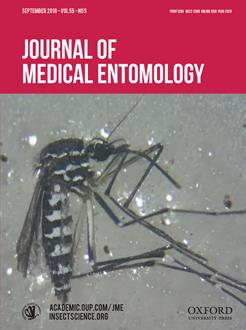Clothing treated with the pyrethroid permethrin is available in the United States as consumer products to prevent tick bites. We used tick bioassays to quantify contact irritancy and toxicity of permethrin-treated clothing for three important tick vectors of human pathogens: the blacklegged tick, Ixodes scapularis Say (Acari: Ixodidae); the lone star tick, Amblyomma americanum (L.) (Acari: Ixodidae); and the American dog tick, Dermacentor variabilis (Say) (Acari: Ixodidae). We first demonstrated that field-collected I. scapularis nymphs from Minnesota were as susceptible as laboratory-reared nymphs to a permethrin-treated textile. Field ticks examined in bioassays on the same day they were collected displayed contact irritancy by actively dislodging from a vertically oriented permethrin-treated textile, and a forced 1-min exposure resulted in all ticks being unable to move normally, thus posing no more than minimal risk of biting, 1 h after contact with the treated textile. Moreover, we documented lack of normal movement for laboratory-reared I. scapularis nymphs by 1 h after contact for 1 min with a wide range of permethrin-treated clothing, including garments made from cotton, synthetic materials, and blends. A comparison of the impact of a permethrin-treated textile across tick species and life stages revealed the strongest effect on I. scapularis nymphs (0% with normal movement 1 h after a 1-min exposure), followed by A. americanum nymphs (14.0%), I. scapularis females (38.0%), D. variabilis females (82.0%), and A. americanum females (98.0%). Loss of normal movement for all ticks 1 h after contact with the permethrin-treated textile required exposures of 1 min for I. scapularis nymphs, 2 min for A. americanum nymphs, and 5 min for female I. scapularis, D. variabilis, and A. americanum ticks. We conclude that use of permethrin-treated clothing shows promise to prevent bites by medically important ticks. Further research needs are discussed.
How to translate text using browser tools
24 May 2018
Contact Irritancy and Toxicity of Permethrin-Treated Clothing for Ixodes scapularis, Amblyomma americanum, and Dermacentor variabilis Ticks (Acari: Ixodidae)
Robert Prose,
Nicole E. Breuner,
Tammi L. Johnson,
Rebecca J. Eisen,
Lars Eisen
ACCESS THE FULL ARTICLE
It is not available for individual sale.
This article is only available to subscribers.
It is not available for individual sale.
It is not available for individual sale.

Journal of Medical Entomology
Vol. 55 • No. 5
September 2018
Vol. 55 • No. 5
September 2018
Amblyomma americanum
bioassay
Dermacentor variabilis
Ixodes scapularis
permethrin-treated clothing




